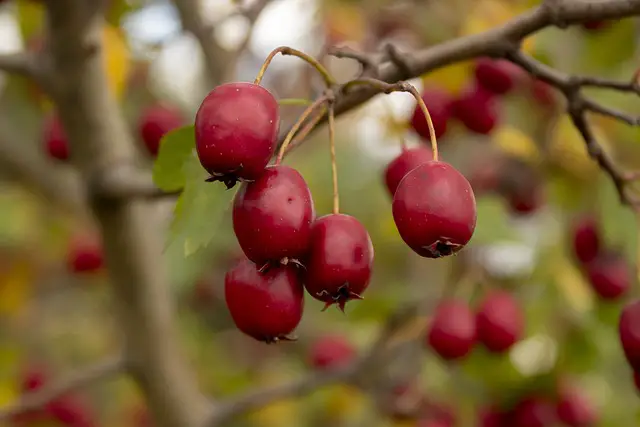Hawthorn trees are deciduous trees that grow in various parts of the world. They are native to temperate regions of the Northern Hemisphere in North America, Europe, North Africa, and parts of Asia. For centuries, people have used their berries, flowers, and leaves in herbal medicine due to their medicinal properties and health benefits.
Are Hawthorn Berries Edible?
The edible berries or “haws” on the Hawthorn are rich in vitamins, minerals, and antioxidants. They have been traditionally used to support heart health and improve blood circulation. Although they have a long history of medicinal use, they can also be consumed as food.
People eat the flesh of the fruit, the flowers, and the young leaves. The young leaves and flower buds are also high in antioxidants. If picked in the spring, they are tender enough to be added to salads. In rural England, the young leaves and flower buds are known as “bread and cheese.”
In the southern United States, the fruits of two different species are known as “mayhaw”, the western mayhaw (Crataegus opaca) and the Eastern Mayhaw (Crataegus aestivalis). These edible fruits are made into jellies that are considered a delicacy.
When at its peak, the flesh of the fruit tastes mild and sweet. It does have a dry and mealy texture a lot of the time, which is similar to other members of the Rosaceae family, like the rose hip.
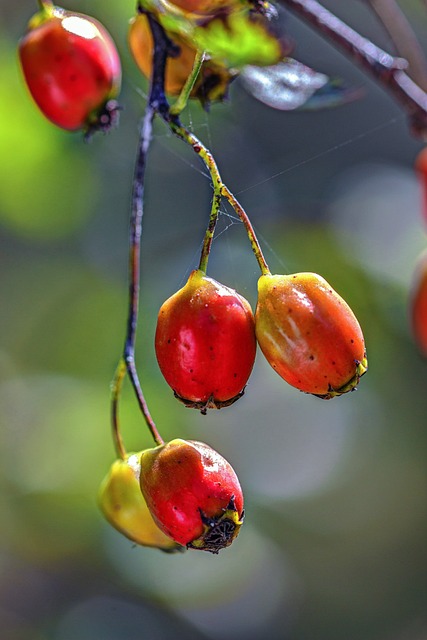
A Note Of Caution When Harvesting Hawthorn Berries
It is important to note that while hawthorn berries are generally safe to eat, there are a few precautions to consider.
The seeds (or seed, as in the case of the Single-seeded Hawthorne) contain amygdalin. This is a compound that can release cyanide when metabolized. For this to happen, someone would have to crush the seeds or crack them open and then eat handfuls of the crushed seeds. Then, they would become very ill and possibly die. The risk of adverse effects is greater with children than it is with adults.
This is why people don’t eat apple seeds or the seeds in cherries, plums, peaches, and other stone fruits. Always spit out the seeds of hawthorn berries.
While the flesh of the berries is not poisonous, some people have reported an unpleasant aftertaste. This may be because the Hawthorn wasn’t at its peak ripeness. This may be an individual experience. If they don’t taste great to you, don’t eat them.
Across North America, there are perhaps a thousand different hawthorn species. There are approximately fifty different kinds in the New England area alone. Fortunately, you don’t need to be able to tell them apart. It’s safe to forage them as long as you are confident they are Hawthorn berries. There may be a slight difference in the size of the berries, the size of the leaves, the seeds, and the flavor. Of course, as a safe foraging practice, you always need to still be confident that they are hawthorns.
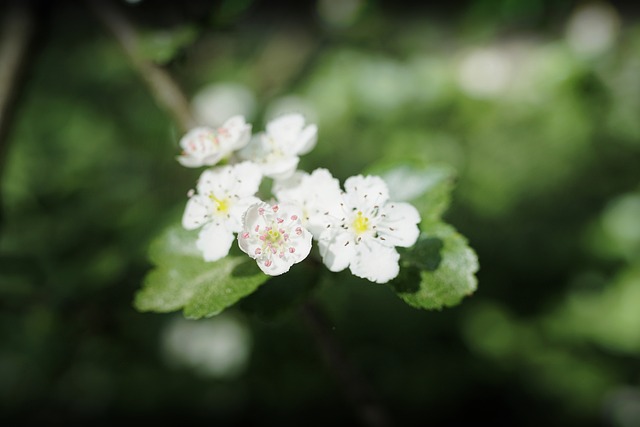
Foraging for Hawthorn Berries
In the late spring, you’ll start seeing the flowers of hawthorn trees. These are edible and can be enjoyed on a salad. The young leaves are also ripe for picking in the late spring when they’re still bright green and fresh. The flowers may be around all summer, depending on the tree, species of Hawthorn, and the weather.
You’ll find the hawthorn berry in the fall. Typically, the red fruit is at its best in mid to late October. If you can pick the berries right after the first frost, you may find a better flavor in your fruit.
The red berries are approximately the size of large blueberries. While we usually refer to them simply as red, the wide variety of native species means that they are also commonly an orange or orange-yellow color, and sometimes even blue or black.
Sometimes people eat these berries right off the tree. They are sometimes a little tart, sometimes sweet, sometimes they have little flavor and are described as simply being “mild”. This difference in flavor depends on how ripe they are, how much sun the tree has been getting, and what species of Hawthorn they are.
Mostly, these berries are popular with people who make hawthorn jelly. The berries have a very high pectin content which makes them a naturally great berry for jams. This also means they can be sweetened with sugar or other berries, which improves their flavor.
The hawthorn genus includes various species, but the common Hawthorn (Crataegus monogyna) is the most widely found and recognized. Look for hawthorn trees in open areas with full sun, such as abandoned farm fields or the edges of woodlands. The trees can grow as small trees or shrubs, and their distinct flowers buzz with the activity of bees and other pollinators.
In North America, the Washington hawthorn (Crataegus phaenopyrum) is a native species that produces red berries. It’s always important to ensure that you have proper identification of the hawthorn species you are foraging to avoid any confusion with other potentially toxic berries.
Keep in mind that red berries are considered to be toxic half the time. So when foraging for any red berries like hawthorn berries, it’s best to be extra cautious.
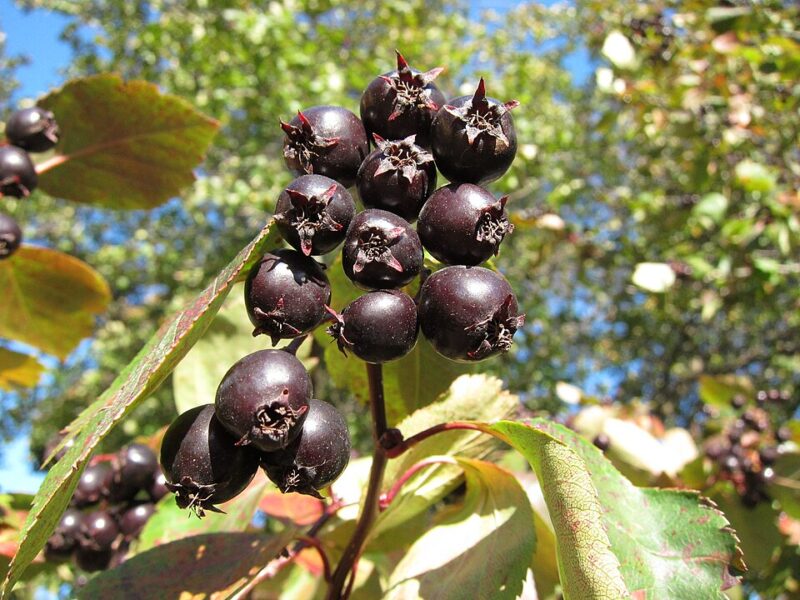
List of Black Fruit Hawthorn in North America
This is just an example of some of the hawthorn varieties in North America. Not all of them are mentioned in this list.
- Blueberry Haw (Crataegus brachyacantha) also goes by Blueberry Hawthorn. They are native to Louisiana and along the border of bordering states.
- Black Hawthorn (Crataegus douglasii), also goes by Douglas’ Thornapple, is found in the Pacific Northwest.
- Chocolate Haw (Crataegus erythropoda) is found in the southern Rocky Mountains
- Okanagan Hawthorn (Crataegus okanaganensis) is native to British Colombia, Montana, and Washington.
- Phipps’ Hawthorne (Crataegus phippsii) is Native to South Central British Colombia, Washington, and Montana.
- River Hawthorn (Crataegus rivularis) is found in the northwestern United States, between the Pacific Coastal ranges and the Rocky Mountains.
- Willow Hawthorn (Crataegus saligna) is found in the wet areas of Northeastern Utah and Western Colorado.
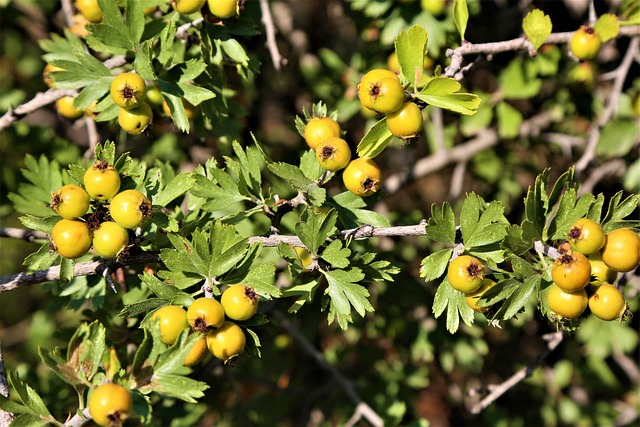
List of Yellow Fruit Hawthorn in North America
This is just an example of some of the hawthorn varieties in North America. Not all of them are mentioned in this list. Also, most of these fruits that are listed are listed under the yellow fruit, but their fruits turn red when ripe.
- Biltmore Hawthorn (Crataegus biltmoreana) is found in the eastern United States. Their fruit is green, yellow, and orange.
- Beadle Hawthorn (Crataegus aprica) is native to the southeastern United States. The fruit of this tree goes through an apricot colored faze before turning red.
- Stinking Hawthorn (Crataegus boyntonii) is found growing in the Southeastern United States. Their fruit is yellowish green and flushed with red.
- Fireberry Hawthorn (Crataegus chrysocarpa), also known as Goldenberry Hawthorn, is native throughout much of Canada and the continental United States. Their unripened fruit is a golden color, while the mature fruit is deep red.
- Copenhagen hawthorn (Crataegus intricate); other common names include Lange’s thorn and Thicket Hawthorn. It is native to eastern Canada and the eastern United States. Its fruit is brown to red.
- Dotted Hawthorn (Crataegus punctate), also known as White Haw, is native to most of the eastern United States and eastern Canada. Their mature fruit varies from deep burgundy, red, yellow, and sometimes yellow with a red cheek.
- Parsley hawthorn (Crataegus marshallii) is found in the southeastern United States. Their mature fruit is red.
- Washington Hawthorn (Crataegus phaenopyrum), or Washington Thorn, is a native to Washington State but is now found throughout the united states. This species produces red berries.
- Single-seeded Hawthorn (Crataegus monogyna) other names include Common Hawthorn, One Seed Hawthorn, Mayblossom, and Mayhorn. They are native to Europe but have been introduced to North America and can be found throughout. They have a single seed. Their fruit is red.
Hawthorn Trees Like Alkaline Soil
Hawthorn berries prefer well-drained soils with a slightly alkaline pH. They have a moderate tolerance for different soil types but generally thrive in loamy or clay loam soils.
The ideal pH range for hawthorn berry growth is between 6.0 and 7.5, slightly leaning toward alkaline conditions. Alkaline soils offer better nutrient availability to the plant, aiding in its overall health and productivity. It is important to note that while hawthorn trees can tolerate a wide range of soil conditions, they may struggle in extremely acidic soils with a pH below 6.0.
If you’re trying to grow Hawthorns in your garden, most gardens are going to have a healthy pH for these trees.
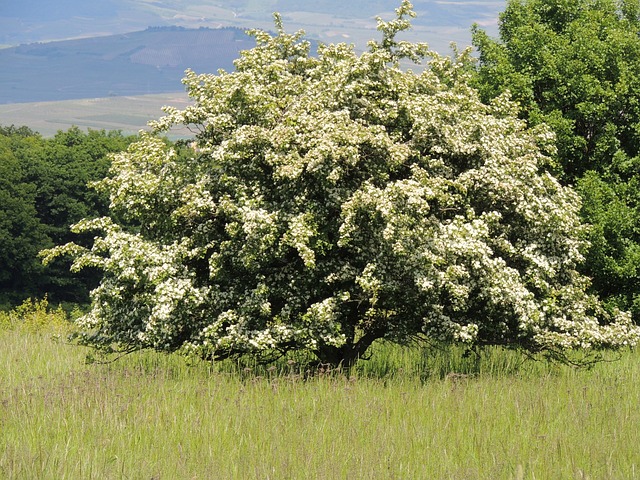
Spotting the Hawthorn Tree
Hawthorn trees typically grow to a height of 10 to 30 feet but can occasionally reach up to 50 feet. They have a rounded to oval-shaped crown with dense foliage.
The leaves of hawthorn trees are deciduous, meaning they shed their leaves annually. They are typically lobed or deeply serrated, giving them an intricate and distinct appearance. The leaves are bright green in color and turn shades of yellow, orange, or red in the autumn. Once the leaves change colors, they don’t taste as good, so it’s better to forage for them in the spring.
Hawthorn trees produce clusters of small, fragrant flowers that bloom in late spring. The flowers are usually white or pink and have a unique characteristic known as the “flowers buzz button.” When touched, the flowers emit a buzzing sound caused by the vibrations of visiting pollinators, such as bees.
Hawthorn trees are known for their sharp thorns, which are present along the branches and stems. These thorns serve as a natural defense mechanism, deterring animals from grazing on the foliage or damaging the tree.
Health Benefits of Hawthorn Berries
These small fruits are packed with nutrients and active compounds that can support heart health, improve blood circulation, and provide a range of other positive effects on the body.
Hawthorn berries have been traditionally used to strengthen and protect the cardiovascular system. Studies have found that hawthorn berries may aid in regulating blood pressure and cholesterol levels, thus reducing the risk of heart conditions such as hypertension and atherosclerosis. The berries work as a vasodilator. This means that it relaxes the blood vessels. In the end, this lowers blood pressure.
These studies are still preliminary and further research is needed to draw strong conclusions. However, hawthorn berries have been used in herbal medicine for centuries and are valued for their medicinal properties, especially where heart health is concerned. Taking in too much of this herbal medicine can cause cardiac arrhythmia and low blood pressure with milder effects like dizziness and nausea.
Hawthorn berries are also rich in antioxidants, which are crucial for combating oxidative stress and reducing the damage caused by free radicals in the body. This may contribute to a lower risk of chronic diseases, including heart disease and certain types of cancer.
These powerful compounds also have anti-inflammatory properties, further supporting overall health and well-being.
It is important to note that while hawthorn berries offer numerous potential health benefits and are a nutrient-rich food source, they are not a substitute for professional medical advice. If you have any existing health conditions or are taking medications, it is advisable to consult with a healthcare professional before incorporating hawthorn extract or berries into your routine, especially if you’re doing so as a replacement for other heart-healthy activities.
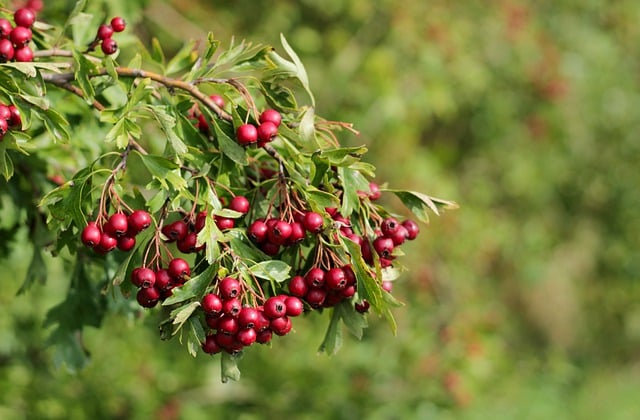
Eating Hawthorn Berries
It is unlikely that you are going to find these fruits at your local grocery store. It’s even uncommon at the farmer’s market. Most people who enjoy hawthorn berries either have a small tree or bush on their property or go foraging for them.
Once you have the berries, what should you do with them?
Well, as mentioned above, you can eat them raw. You’ll want to avoid the seeds.
You can use them to make jams. They have a high pectin content, which makes them great for this. The high pectin content also makes them a great choice for filling in desserts like pies and pastries.
You can also use them to make syrup. Hawthorn syrup is fairly popular in the Southeast United States.
You can dry the berries, flowers, or the leaves. Then, you can use the dried Hawthorn to make tea. This is also an item you can actually find at the grocery store.
You can ferment hawthorn berries. When you do this, you can use them to make vinegar for a salad dressing, or you can use them to make alcohol. A lot of people use hawthorn berries to make wine.
If you’re looking to incorporate Hawthorn into your diet for the health benefits and don’t want to forage for the berries, you can find hawthorn supplements. These come as pills and powders.
Hawthorn Berries Are A Popular Treat, Especially With Foragers
Yes, the berries from these small trees are edible. They’ll often be found growing in the full sun, though you may notice them growing in partial shade. They grow on college campuses as well as they do in abandoned farm fields. Make sure you remove the seeds, as you would with apple seeds or cherry pits.
Enjoy these sometimes tart, sometimes mildly sweet, berries as a treat on the trail or collect them and use them in your baking or for making jams. Reap the benefits of their high antioxidant content. And as always, make sure that when you’re foraging, you use more than one source to correctly identify the tree.
Recent Posts
The only venomous snakes in Washington State are Northern Pacific Rattlesnakes. The Northern Pacific Rattlesnake (Crotalus oreganus oreganus) is a sub-species of the Western Rattlesnake. Anyone...
Skunks are not classified as true hibernators. But they go into a state of torpor when the weather gets cold. Skunks are light sleep hibernators, along with opossums, bears, and raccoons. ...

